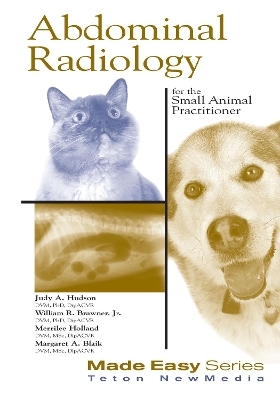
Abdominal Radiology for the Small Animal Practitioner
Teton NewMedia
978-1-893441-34-7 (ISBN)
This text is meant to be a handy cookbook which can be quickly grabbed from the self and provide the practitioner with essential information on abdominal radiography. This practical presentation consists of the uses and interpretations of abdominal plain film for the small animal practitioner or technician. The text describes the normal appearance of the abdomen, ways in which the radiographic appearance changes to reflect disease, and common abdominal disorders. Discussions in the text also include techniques for better radiographs and steps to good film reading. The lay-flat binding is ideal for practical use in the clinic.
Published by Teton New Media in the USA and distributed by CRC Press outside of North America.
Section1 Introduction and
Radiographic Technique
Some Helpful Hints
Indications for Abdominal Radiography
Role of Radiology in Patient Management
Steps to Good Film Reading
Step One: Technical Factors for
Abdominal Radiography
Step Two: Using a System for Interpretation
Step Three: Roentgen or Radiographic Signs
Step Four: Differential Diagnoses
Step Five: What’s Next?
Section2Normal Radiographic
Anatomy of the Abdomen
Viewing the Film
Stomach
Duodenum
Cecum
Kidney
Spleen
Diaphragm
Liver
Bladder
Prostate
Lymph Nodes
Section3Peritoneal Cavity
Normal Appearance
Increased Peritoneal Opacity
Terminology – Synonyms
Decreased Peritoneal Opacity–Gas
Causes of Intraluminal Gas Accumulation
Causes of Extraluminal Gas Accumulation
Radiographic (Roentgen)
Signs of Extraluminal Gas
Decreased Peritoneal Opacity–Fat
Causes of Abnormal Fat Opacities
Radiographic (Roentgen) Signs
Disruption of Borders of the Peritoneal Cavity
Diaphragmatic Hernia
Hiatal Hernia
Peritoneopericardial Hernia
Inguinal or Ventral Hernia
Perineal Hernia
Section4 Intra-abdominal Masses
Evaluation of an Abdominal Mass
Gastric Masses
Generalized Hepatomegaly
Focal Hepatomegaly
Differentiate the Stomach
Renal Masses
Adrenal Mass
Diffuse Splenomegaly
Focal Splenomegaly
Mesenteric/Enteric Masses
Pancreatic Masses
Ovarian Masses
Masses Involving Urinary Bladder
Prostatic Masses
Uterine Masses
Caudal Sublumbar Masses
Section5Alimentary Tract
Contrast Media
Barium
Ionic Organic Iodine
Non-Ionic Organic Iodine Preparations
Esophageal/Gastrointestinal Contrast Procedures
Radiography of the Esophagus
Contrast Examination of the Esophagus–Esophagram
Esophagram Technique
Disorders of the Esophagus
Esophageal Foreign Bodies
Megaesophagus
Vascular Ring Anomalies
Esophageal Masses
Radiography of the Stomach and Small Intestine
Survey Radiographs
Contrast Examination of the
Stomach and Small Intestine–Indications
Upper Gastrointestinal Series
Normal Upper GI Series
Stomach
Small Intestine
Differences in Cats
Principles of Interpretation
Other Contrast Procedures
Upper GI Series with Iodine
Pneumogastrogram
Double Contrast Gastrogram
Disorders of the Stomach
Gastric Foreign Body
Gastric Torsion/Dilatation
Pyloric Outflow Obstruction
Gastric Neoplasia
Gastroesophageal Intussusception
Disorders of Small Intestine
Ileus
Mechanical Obstruction
Foreign Body
Intussusception
Inflammatory Diseases Without Ulceration
Ulcers
Infiltrative Disease
Radiography of the Large Intestine
Contrast Radiography of the Large Intestine
Pneumocolography
Barium Enema
Double Contrast Barium Enema
Disorders of the Large Intestine
Obstipation
Ileocolic Intussusception
Cecal Inversion
Infiltrative Diseases
Mucosal Diseases (Colitis)
Section6Urinary Tract
Selection of Appropriate Contrast Procedure
Contrast Examination of the Urinary Bladder
(Cystography)
Positive Contrast Cystogram
Negative Contrast Cystogram (Pneumocystogram)
Double Contrast Cystogram
Vesicoureteral Reflux
Disorders of the Urinary Bladder
Urinary Calculi
Ruptured Bladder
Cystitis
Emphysematous Cystitis
Urinary Bladder Neoplasia
Contrast Examination of the Urethra (Urethrography)
Disorders of the Urethra
Urethral Calculi
Obstructive Uropathy
Ruptured Urethra
Contrast Examination of the Kidneys and
Ureters–Excretory Urogram
Normal Excretory Urogram
Arteriogram Phase
Nephrogram Phase
Pyelogram Phase
Cystogram Phase
Disorders of the Kidneys and Ureters
Chronic Renal Disease
Renal Dysplasia
Transitional Cell Carcinoma of the Urinary Bladder
Hydronephrosis
Renal Calculi
Pyelonephritis
Renal Neoplasia
Polycystic Renal Disease
Perirenal Pseudocyst
Compensatory Hypertrophy
Functional Evaluation of the Kidney
Ruptured Ureter
Ureteral Ileus
Ureteral Calculi
Primary Ureteritis
Ectopic Ureter
Section7Reproductive Tract
Female: Uterus and Ovaries
Pregnancy
Disorders of the Female Reproductive Tract
Pyometra and Other Causes of
Uterine Enlargement
Dystocia
Fetal Death
Ovarian Neoplasia
Disorders of the Male Reproductive Tract
Retained Testicles and Prostate Gland
Testicular Masses
Prostatic Enlargement
Benign Prostatic Hyperplasia
Prostatitis
Prostatic Abscess
Prostatic Neoplasia
Prostatic and Paraprostatic Cysts
Section8Anomalies
Microhepatica
Renal Agenesis
Malpositioned Kidneys
Kartagener’s Syndrome
Recommended Readings
| Erscheint lt. Verlag | 11.12.2001 |
|---|---|
| Reihe/Serie | Made Easy Series |
| Verlagsort | Jackson |
| Sprache | englisch |
| Gewicht | 363 g |
| Themenwelt | Naturwissenschaften ► Biologie ► Zoologie |
| Veterinärmedizin ► Klinische Fächer ► Bildgebende Verfahren | |
| Veterinärmedizin ► Kleintier | |
| ISBN-10 | 1-893441-34-2 / 1893441342 |
| ISBN-13 | 978-1-893441-34-7 / 9781893441347 |
| Zustand | Neuware |
| Haben Sie eine Frage zum Produkt? |